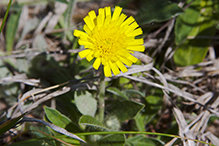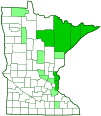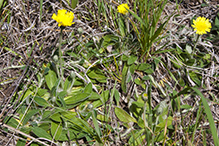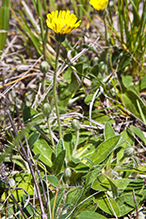mouse-ear hawkweed
(Pilosella officinarum)
Conservation • Description • Habitat • Ecology • Use • Distribution • Taxonomy
Conservation Status |
|
|||||||
| IUCN Red List | not listed |
|||||||
| NatureServe | NNA - Not applicable SNA - Not applicable |
|||||||
| Minnesota | not listed |
|||||||
Description |
||
Mouse-ear hawkweed is an erect, perennial forb that rises on a rosette of basal leaves and a solitary flowering stalk (scape) from fibrous roots and a long, slender, vertical rhizome. It is usually 4″ to 10″ in height at maturity, though some individuals may be up to 16″ tall. It reproduces mostly by abundant aboveground stems (stolons) that creep along the ground and produce a new plant at the tip. When the daughter plants have been formed, the mother plant dies. It eventually forms a dense mat that crowds out other vegetation. There are usually 5 to 10 or more basal leaves firmly appressed to the ground. The leaves are ¾″ to 5″ long and ¼″ to ¾″ wide. The leaf blades are elliptic to inversely lance-shaped, unlobed, wedge-shaped at the base and broadly angled at the tip. They are 2 to 4 or more times as long as wide. The upper surface is green with few to many pale, soft, nonglandular, 1 ⁄16″ to ¼″ long hairs, sometimes with a few star-shaped hairs, but otherwise hairless. The lower surface is gray or whitish, densely covered with star-shaped hairs, and sparsely covered with long, soft hairs. The margins are untoothed or nearly untoothed and are sparsely covered with long, soft hairs. Basal leaves are present at flowering time. There are usually 2 to 6 stolons. The stolons are slender, prostrate, leafy, up to 12″ long, and sometimes branched. They are covered with soft, tangled hairs and soft, straight hairs. They root at the tip and form a rosette of overwintering leaves. The leaves on the stolons are similar to the basal leaves but smaller. The inflorescence is usually a single flower head at the end of a solitary, unbranched, leafless scape. Rarely there may be 2 or 3 flower heads. The scape is densely covered with star-shaped hairs, unbranched hairs, and gland-tipped hairs. There are numerous soft hairs with dark bases scattered over the entire scape. There are dark, gland-tipped hairs especially dense toward the flower head. The whorl of bracts at the base of the flower head (involucre) is ¼″ to 7 ⁄16″long and half globe-shaped to inversely cone-shaped. The bracts of the involucre are linear lance-shaped. They are densely covered with star-shaped hairs; with black, broad-based, glandular hairs; and with longer, black-based, nonglandular hairs. Each flower head has 60 to 120 yellow, 5 ⁄16″ to ½″ long ray florets and no disk florets. The outermost ray florets have a red vertical stripe on the underside. The fruit is a 1 ⁄32″ to 1 ⁄16″ long, 1 ⁄64″ wide cypsela with 30 or more white bristles attached to the end. It is dispersed by wind. |
||
Height |
||
4″ to 10″ |
||
Flower Color |
||
Yellow |
||
Similar Species |
||
|
||
Habitat |
||
Dry. Pastures, fields, roadsides, lawns, disturbed sites. Full sun. Sandy or gravelly soil. |
||
Ecology |
||
Flowering |
||
May to August |
||
Pests and Diseases |
||
|
||
Use |
||
|
||
Distribution |
||||
|
Sources 2, 3, 4, 5, 7, 22, 28, 29, 30. The counties in light green on the map are counties in which there are citizen science records on iNaturalist but no records from other sources. |
|||
| 5/15/2023 | ||||
Nativity |
||||
Native to Europe and Asia. Introduced and naturalized in North America. |
||||
Occurrence |
||||
|
||||
Taxonomy |
|||
| Kingdom | Plantae (Plants) | ||
| Subkingdom | Pteridobiotina | ||
| Phylum | Tracheophyta (Vascular Plants) | ||
| Class | Magnoliopsida (Dicots) | ||
Order |
Asterales (Sunflowers, Bellflowers, Fanflowers, and Allies) | ||
Family |
Asteraceae (Sunflowers, Daisies, Asters, and Allies) | ||
| Subfamily | Cichorioideae (chicories, dandelions, and allies) | ||
| Tribe | Cichorieae (lettuce, chicory, dandelion, and salsify) | ||
| Subtribe | Hieraciinae (hawkweeds) | ||
| Genus | Pilosella (mouse-ear hawkweeds) | ||
Until recently, plants in the genus Pilosella were grouped as a subgenus of Hieracium. Distinct features of the cypsela, absence of hybridization between groups, and, in some species, the presence of runners (stolons) and/or red lines on the lower (abaxial) ligule surface, support the segregation of these species into a separate genus. |
|||
Subordinate Taxa |
|||
|
|||
Synonyms |
|||
Hieracium pilosella Hieracium pilosella var. niveum Hieracium pilosella var. pilosella |
|||
Common Names |
|||
mouseear hawkweed mouse-ear hawkweed |
|||
Glossary
Bract
Modified leaf at the base of a flower stalk, flower cluster, or inflorescence.
Cypsela
A dry, one-chambered, single-seeded fruit, formed from a single carpel, with the seed attached to the membranous outer layer (wall) only by the seed stalk; the wall, formed from the wall of the inferior ovary and also from other tissues derived from the receptacle or hypanthium, does not split open at maturity, but relies on decay or predation to release the contents.
Glandular hairs
Hairs spread over aerial vegetation that secrete essential oils. The oils act to protect against herbivores and pathogens or, when on a flower part, attract pollinators. The hairs have a sticky or oily feel.
Involucre
A whorl of bracts beneath or surrounding a flower, flower head, or flower cluster.
Rhizome
A horizontal, usually underground stem. It serves as a reproductive structure, producing roots below and shoots above at the nodes.
Scape
An erect, leafless stalk growing from the rootstock and supporting a flower or a flower cluster.
Stolon
An above-ground, creeping stem that grows along the ground and produces roots and sometimes new plants at its nodes. A runner.

Visitor Videos |
|||
Share your video of this plant. |
|||
| This button not working for you? Simply email us at info@MinnesotaSeasons.com. Attach a video, a YouTube link, or a cloud storage link. |
|||
Other Videos |
|||
| Herbal medicine - video 10 - Mouse Ear-Hawkweed (Hieracium pilosella) junglist4789's channel |
|||
About
Uploaded on Jul 2, 2010 Herbal Medicine - Mouse Ear Hawkweed - 2. July 2010 |
|||
| Jastrzębiec kosmaczek HUJ00000 |
|||
About
Published on May 31, 2012 Jastrzębiec kosmaczek Jastrzębiec kosmaczek, ludowa nazwa niedośpiałek (Hieracium pilosella L.) -- gatunek rośliny z rodziny astrowatych. Rodzimy obszar jego występowania to Europa i część terytorium Azji (Kaukaz, Zakaukazie, Dagestan i Syberia Zachodnia). Rozprzestrzenił się także jako gatunek zawleczony w Australii, Nowej Zelandii i w Ameryce Północnej. W Polsce występuje na całym terenie kraju. Morfologia Pokrój Łodyga Liście Kwiat Owoce Biologia i ekologia Siedlisko: występuje na suchych stanowiskach: piaszczystych, murawach, wrzosowiskach, przydrożnych poboczach, gdzie tworzy często zwarte płaty. Lubi gleby suche, piaszczyste, słabo nawożone. Unika miejsc silnie zacienionych. W Tatrach występuje aż po piętro alpejskie. W uprawach rolnych chwast rozrastający się przez rozłogi, ale łatwy do zwalczenia, gdyż jest bardzo wrażliwy na selektywne herbicydy. W klasyfikacji zbiorowisk roślinnych gatunek charakterystyczny dla klasy (Cl.) Nardo-Callunetea-. Roślina trująca. Zmienność Zastosowanie Stosowane są do leczenia: nieżytu przewodu pokarmowego, złej przemiany materii, biegunki, czerwonki, wrzodów żołądka i dwunastnicy, chorób płuc i kamicy nerkowej Zewnętrznie leczy rany, wrzody, czyraki i ropną wysypkę. Ciekawostki W medycynie ludowej stosowany był do leczenia ukąszeń: owadów, psów i gadów. Posiada właściwości allelopatii, czyli oddziaływań między roślinami jako truciciel. |
|||

Visitor Sightings |
|||||
Report a sighting of this plant. |
|||||
| This button not working for you? Simply email us at info@MinnesotaSeasons.com. Be sure to include a location. |
|||||
|
|||||
MinnesotaSeasons.com Sightings |
|||||

|
Created: Last Updated: © MinnesotaSeasons.com. All rights reserved. |






